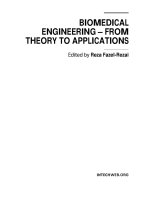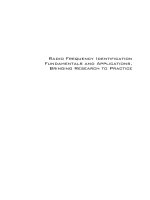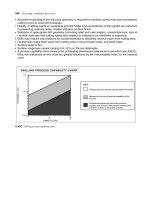Swarm Robotics, From Biology to Robotics Part 1 pot
Bạn đang xem bản rút gọn của tài liệu. Xem và tải ngay bản đầy đủ của tài liệu tại đây (271.88 KB, 10 trang )
I
Swarm Robotics,
From Biology to Robotics
Swarm Robotics,
From Biology to Robotics
Edited by
Ester Martínez Martín
In-Tech
intechweb.org
Published by In-Teh
In-Teh
Olajnica 19/2, 32000 Vukovar, Croatia
Abstracting and non-prot use of the material is permitted with credit to the source. Statements and
opinions expressed in the chapters are these of the individual contributors and not necessarily those of
the editors or publisher. No responsibility is accepted for the accuracy of information contained in the
published articles. Publisher assumes no responsibility liability for any damage or injury to persons or
property arising out of the use of any materials, instructions, methods or ideas contained inside. After
this work has been published by the In-Teh, authors have the right to republish it, in whole or part, in any
publication of which they are an author or editor, and the make other personal use of the work.
© 2010 In-teh
www.intechweb.org
Additional copies can be obtained from:
First published March 2010
Printed in India
Technical Editor: Maja Jakobovic
Cover designed by Dino Smrekar
Swarm Robotics, From Biology to Robotics,
Edited by Ester Martínez Martín
p. cm.
ISBN 978-953-307-075-9
V
Preface
In nature, it is possible to observe a cooperative behaviour in all animals, since, according
to Charles Darwin’s theory, every being, from ants to human beings, form groups in which
most individuals work for the common good. However, although study of dozens of social
species has been done for a century, details of how and why cooperation evolved remain
to be worked out. Actually, cooperative behaviour has been studied from different points
of view. For instance evolutionary biologists and animal behaviour researchers look for the
genetic basis and molecular drivers of this kind of behaviours, as well as the physiological,
environmental, and behavioural impetus for sociality; while neuroscientists discover key
correlations between brain chemicals and social strategies. From a more mathematical point
of view, economics have developed a modelling approach, based on game theory, to quantify
cooperation and predict behavioural outcomes under different circumstances. Although
game theory has helped to reveal an apparently innate desire for fairness, developed models
are still imperfect. Furthermore, social insect behaviour, from a biological point of view, might
be emulated by a micro-robot colony and, in that way, analysis of a tremendous amount of
insect trajectories and manual event counting is replaced by tracking several miniature robots
on a desktop table.
Swarm robotics is a new approach that emerged on the eld of articial swarm intelligence, as
well as the biological studies of insects (i.e. ants and other elds in nature) which coordinate
their actions to accomplish tasks that are beyond the capabilities of a single individual. In
particular, swarm robotics is focused on the coordination of decentralised, self-organised
multi-robot systems in order to describe such a collective behaviour as a consequence of local
interactions with one another and with their environment.
Research in swarm robotics involves from robot design to their controlling behaviours, by
including tracking techniques for systematically studying swarm-behaviour. Moreover,
swarm robotic-based techniques can be used in a number of applications. This is, for instance,
the case of the Particle Swarm Optimization (PSO) which is a direct search method, based
on swarm concepts, that models and predicts social behaviour in the presence of objectives.
In this case, the swarm under study is typically modelled by particles in multidimensional
space that have two essential reasoning capabilities: their memory of their own best position
and the knowledge of the global or their neighbourhood’s best, such that swarm members
communicate good positions to each other and adjust their own position and velocity based
on those good positions in order to obtain the best problem solution.
Different challenges have to be solved in the eld of swarm robotics. This book is focused
on real practical applications by analyzing how individual robotic agents should behave in a
robotic swarm in order to achieve a specic goal such as target localization or path planning.
VI
In this context, the rst paper, by Hereford and Siebold, concentrates on looking for a target
in a room. They describe, on the one hand, the way a PSO algorithm, based on bird ocking,
may be embedded into a robot swarm; and, on the other, the implementation of a four-step
trophallactic behaviour of social insects in a robotic platform by making sensor measurements
instead of exchanging information when two or more particles are in contact. Different
software and hardware tests were developed to evaluate both search strategy performances.
Another issue which may be solved by PSO methods is the robotic cell problem, where each
integrating machine could be identied as a member of a swarm. In this context, Kamalabadi
et al. present a hybrid PSO algorithm to nd a schedule robot movement to minimize cycle
time when multiple-type parts three-machine robotic cells are considered. Its performance
has been compared with three well-known metaheuristic algorithms: Genetic Algorithm
(GA), Basic Algorithm (PSO-
I) and Constriction Algorithm (PSO-II), by succeeding in the most problems, especially for
large-sized ones.
The next two papers have focused on the problem of path planning for mobile robots. Firstly,
Curkovic et al. introduce a way to solve the navigation problem for a robot in a workspace
containing differently shaped and distributed by means of a simplication of Honey Bees
Mating Algorithm. Moreover, a plan optimization technique that results in a minimization
of the required time or the travelled distance is proposed. Again, method performance is
successfully evaluated with respect to the Genetic Algorithm. Secondly, Xue et al. apply
PSO-type control for real-time path planning on a typical swarm of wheeled mobile robots
in an unstructured environment. Furthermore, an overview of a system modelling at both
individual and swarm levels as well as a fusion-framework is presented. Their study was
tested through virtual signal generators and simulations about swarm-component measuring
and fusing.
Another application of the PSO techniques is the design of an innite impulse response (IIR)
digital lter of robot force/position sensors. Zhang proposes an IIR lter design from the
knowledge of the structure of a lter and master of an intelligent optimization algorithm.
The PSO algorithm is then used to optimize parameter values. Newly, simulation is used to
validate the developed technique.
Finally, it is essential to systematically study and test swarm-behaviour by analyzing what
each swarm member is doing as well as where and when it acts. For that purpose, Martínez
and del Pobil has developed a visual application that robustly identies and tracks all robotic
swarm members. Different situations and visual systems were studied to achieve that goal.
Experimental results on a real system are also presented.
This book has only provided a partial picture of the eld of swarm robotics by focusing on
practical applications. The global assessment of the contributions contained in this book is
reasonably positive since they highlighted that it is necessary to adapt and remodel biological
strategies to cope with the added complexity and problems that arise when robot individuals
are considered.
Ester Martínez Martín
VII
Contents
Preface V
1. Bio-inspiredsearchstrategiesforrobotswarms 001
JamesM.HerefordandMichaelA.Siebold
2. ANewHybridParticleSwarmOptimizationAlgorithm
totheCyclicMultiple-PartTypeThree-MachineRoboticCellProblem 027
IsaNakhaiKamalabadi,AliHosseinMirzaeiandSaeedeGholami
3. ComparisonofSwarmOptimizationandGeneticAlgorithm
forMobileRobotNavigation 047
PetarĆurković,BojanJerbićandTomislavStipančić
4. KeyAspectsofPSO-TypeSwarmRoboticSearch:SignalsFusion
andPathPlanning 059
SongdongXue,JianchaoZengandJinweiGuo
5. OptimizationDesignMethodofIIRDigitalFiltersforRobot
ForcePositionSensors 081
FuxiangZhang
6. VisualAnalysisofRobotandAnimalColonies 091
E.MartínezandA.P.delPobil
VIII
Bio-inspiredsearchstrategiesforrobotswarms 1
Bio-inspiredsearchstrategiesforrobotswarms
JamesM.HerefordandMichaelA.Siebold
X
Bio-inspired search strategies for robot swarms
James M. Hereford and Michael A. Siebold
Murray State University, Murray, KY
USA
1. Introduction
Our goal is as follows: build a suite/swarm of (very) small robots that can search a room for
a “target”. We envision that the robots will be about the size of a quarter dollar, or smaller,
and have a sensor or sensors that “sniff” out the desired target. For example, the target
could be a bomb and the robot sensors would be a chemical detectors that can distinguish
the bomb from its surroundings. Or the target could be a radiation leak and the sensors
would be radiation detectors. In each search scenario, we assume that the target gives off a
diffuse residue that can be detected with a sensor.
It is not very efficient to have the suite of robots looking randomly around the room hoping
to “get lucky” and find the target. There needs to be some way to coordinate the
movements of the many robots. There needs to be an algorithm that can guide the robots
toward promising regions to search while not getting distracted by local variations. The
search algorithm must have the following constraints:
The search algorithm should be distributed among the many robots. If the algorithm is
located in one robot, then the system will fail if that robot fails.
The search algorithm should be computationally simple. The processor on each bot is
small, has limited memory, and there is a limited power source (a battery) so the
processor needs to be power efficient. Therefore, the processor will be a simple
processor.
The algorithm needs to be scalable from one robot up to 10’s, 100’s, even 1000’s of
robots. The upper limit on the number of robots will be set by the communication links
among the robots; there needs to be a way to share information among the robots
without requiring lots of communication traffic.
The search algorithm must allow for contiguous movement of the robots.
This chapter will describe two search strategies for robot swarms that are based on
biological systems. The first search strategy is based on the flocking behavior of birds and
fishes. This flocking behavior is the inspiration behind the Particle Swarm Optimization
(PSO) algorithm that has been used in software for many types of optimization problems. In
the PSO algorithm the potential solutions, called particles, “fly” through the problem space
by following some simple rules. All of the particles have a fitness value based on the value
or measurement at the particle’s position and have velocities which direct the flight of the
particles. The velocity of each particle is updated based on the particle’s current velocity as
well as the best fitness of any particle in the group.
1
SwarmRobotics,FromBiologytoRobotics2
We describe how the PSO algorithm can be embedded into a robot swarm by letting each
bot’s behavior be like a particle in the PSO. We call the algorithm the physically embedded
PSO (pePSO). The bots swarm throughout the search space and take measurements. Over
time, they cluster near the peak(s) or targets. We show through both 2D simulation results
and robot hardware results that the pePSO effectively finds the targets with a minimum
number of bot-bot communications.
The second search strategy is based on the trophallactic behavior of social insects.
Trophallaxis is the exchange of fluid by direct mouth-to-mouth contact. This phenomenon is
observed in ants, bees, wasps and even dogs and birds. In our trophallaxis-based algorithm,
the bots do not actually exchange information but instead make sensor measurements when
two or more bots/particles are “in contact”. The bots remain stationary for a certain time
that is proportional to the measurement value. Bots thus cluster in areas of the search space
that have high fitness/measurement values.
This new trophallaxis-based search algorithm has several advantages over other swarm-
based search techniques. First, no bot-bot communication is required. Thus, there is no
concern with communication radius, protocol, or bandwidth. Second, the bots do not have
to know their position. During the search, the bot/particle moves randomly except when it
collides and stops, takes a measurement, and waits. At the end of the search, the cluster
locations can be determined from a remote camera, special-purpose robot, or human
canvassing.
This paper is organized as follows: section 2 gives background on the Particle Swarm
Optimization algorithm and its use in robot swarms and section 3 gives results from
simulations and hardware results of embedding the PSO into a robot swarm. Section 4
discusses the trophallaxis- based search algorithm and section 5 gives simulation results
using the trophallaxis algorithm. In section 6 we give our conclusions.
2. Particle Swarm Optimization and robots
In Particle Swarm Optimization (PSO) (Eberhart & Kennedy, 1995; Clerc &Kennedy, 2002;
Eberhart & Shi, 2004), the potential solutions, called particles, “fly” through the problem
space by following some simple rules. All of the particles have fitness values based on their
position and have velocities which direct the flight of the particles. PSO is initialized with a
group of random particles (solutions), and then searches for optima by updating
generations. In every iteration, each particle is updated by following two "best" values. The
first one is the best solution (fitness) the particle has achieved so far. This value is called
pbest. Another "best" value that is tracked by the particle swarm optimizer is the best value
obtained so far by any particle within the neighborhood. This best value is a neighborhood
or local best and called lbest.
After finding the two best values, the particle updates its velocity and positions with
following equations:
n
p
n
lbestrc
n
p
n
pbestrc
n
v
i
w
n
v
*2*2*1*1
1
(1)
11
n
v
n
p
n
p
(2)
w
i
is the inertia coefficient which slows velocity over time; v
n
is the current particle velocity;
p
n
is the current particle position in the search space; r1 and r2 are random numbers
between (0,1); c1 and c2 are learning factors. The stop condition is usually the maximum
number of allowed iterations for PSO to execute or the minimum error requirement.
Because of the required search algorithm characteristics listed in section 1, we chose the PSO
as the starting point for the search control algorithm. The PSO is computationally simple. It
requires only four multiplies and four add/subtracts to update the velocity and then one
add to update the position. The PSO can also be a distributed algorithm. Each
agent/particle/bot can update its own velocity and position. The only external information
is the local best – the best value by any particle within the neighborhood. The calculation of
the local best can be done with a simple comparative statement. Thus, each bot does not
need to know the results from each member of the population as in many traditional
schemes. (Though in some versions of the PSO, the lbest is replaced by gbest, the global
best – the best value of any particle within the population.)
The PSO also allows the contiguous movement of the bots. The updated position is relative
to the current position so there are no jump changes in position or random movements. If
there are constraints on the movement of the bot during each iteration, then limitations can
be placed on the maximum and minimum velocity that is allowed for each particle/bot.
We propose embedding the PSO into a swarm of robots. In our approach, each bot is
behaves as one particle in the PSO. Thus, each bot moves based on the PSO update
equations (eqs. 1 and 2), makes a measurement and then broadcasts to the other bots in the
swarm if it finds a new lbest measurement. We make some slight changes to the classic PSO
algorithm to make it work with a robot swarm, so we call our algorithm the physically-
embedded PSO (pePSO).
Other authors have investigated using biological principles (Zarzhitsky & Spears, 2005;
Valdastri et al., 2006; Schmickl & Crailsheim, 2006; Triannni et al., 2006) and PSO-type
algorithms (Hayes et al., 2000; Hayes et al., 2002, Doctor et al., 2004; Pugh & Martinoli, 2006;
Pugh & Martinoli, 2007; Jatmiko et al., 2006; Jatmiko et al., 2007) with multiple (simple)
robots for search applications. Specifically, Hayes et al. report using autonomous mobile
robots for beacon localization (Hayes et al., 2000) and plume tracking/odor source
localization (Hayes et al., 2002); they base their search techniques on biological principles
(surge “upwind”) but do not use the PSO algorithm directly. Doctor et al. (Doctor et al.,
2004) discuss using the PSO for multiple robot searches. Their focus is on optimizing the
parameters of the search PSO and do not consider the scalability of the standard PSO to
large numbers of robots.
There are at least three other research groups that have investigated using mobile robots to
do searches under the control of a PSO algorithm. Pugh et al. (Pugh & Martinoli, 2006; Pugh
& Martinoli, 2007), explored using PSO on problems in noisy environments, focusing on
unsupervised robotic learning. They used the PSO to evolve a robot controller that avoids
obstacles and finds the source. They also investigated the possibility of using PSO without
global position information. Jatmiko et al. (Jatmiko et al., 2006; Jatmiko et al., 2007) used
mobile robots for plume detection and traversal. They utilized a modified form of the PSO
to control the robots and consider how the robots respond to search space changes such as
turbulence and wind changes. Akat and Gazi (Akat and Gazi, 2008) propose a version of
the PSO for robot swarms that uses dynamic neighborhoods and asynchronous updates.









